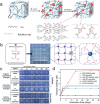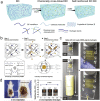Tailoring the Swelling-Shrinkable Behavior of Hydrogels for Biomedical Applications
- PMID: 37544909
- PMCID: PMC10558674
- DOI: 10.1002/advs.202303326
Tailoring the Swelling-Shrinkable Behavior of Hydrogels for Biomedical Applications
Abstract
Hydrogels with tailor-made swelling-shrinkable properties have aroused considerable interest in numerous biomedical domains. For example, as swelling is a key issue for blood and wound extrudates absorption, the transference of nutrients and metabolites, as well as drug diffusion and release, hydrogels with high swelling capacity have been widely applicated in full-thickness skin wound healing and tissue regeneration, and drug delivery. Nevertheless, in the fields of tissue adhesives and internal soft-tissue wound healing, and bioelectronics, non-swelling hydrogels play very important functions owing to their stable macroscopic dimension and physical performance in physiological environment. Moreover, the negative swelling behavior (i.e., shrinkage) of hydrogels can be exploited to drive noninvasive wound closure, and achieve resolution enhancement of hydrogel scaffolds. In addition, it can help push out the entrapped drugs, thus promote drug release. However, there still has not been a general review of the constructions and biomedical applications of hydrogels from the viewpoint of swelling-shrinkable properties. Therefore, this review summarizes the tactics employed so far in tailoring the swelling-shrinkable properties of hydrogels and their biomedical applications. And a relatively comprehensive understanding of the current progress and future challenge of the hydrogels with different swelling-shrinkable features is provided for potential clinical translations.
Keywords: biomedical applications; high-swelling hydrogels; hydrogels; non-swelling hydrogels; shrinkable hydrogels.
© 2023 The Authors. Advanced Science published by Wiley-VCH GmbH.
Conflict of interest statement
The authors declare no conflict of interest.
Figures





















Similar articles
-
Advances in versatile anti-swelling polymer hydrogels.Mater Sci Eng C Mater Biol Appl. 2021 Aug;127:112208. doi: 10.1016/j.msec.2021.112208. Epub 2021 May 27. Mater Sci Eng C Mater Biol Appl. 2021. PMID: 34225860 Review.
-
Stimuli-Responsive Hydrogel Adhesives for Wound Closure and Tissue Regeneration.Macromol Biosci. 2024 Mar;24(3):e2300379. doi: 10.1002/mabi.202300379. Epub 2023 Oct 18. Macromol Biosci. 2024. PMID: 37827713 Review.
-
Heparinized silk fibroin hydrogels loading FGF1 promote the wound healing in rats with full-thickness skin excision.Biomed Eng Online. 2019 Oct 2;18(1):97. doi: 10.1186/s12938-019-0716-4. Biomed Eng Online. 2019. PMID: 31578149 Free PMC article.
-
Adhesive Hemostatic Conducting Injectable Composite Hydrogels with Sustained Drug Release and Photothermal Antibacterial Activity to Promote Full-Thickness Skin Regeneration During Wound Healing.Small. 2019 Mar;15(12):e1900046. doi: 10.1002/smll.201900046. Epub 2019 Feb 20. Small. 2019. PMID: 30786150
-
Synthesis and Characterization of Novel pH-Responsive Aminated Alginate Derivatives Hydrogels for Tissue Engineering and Drug Delivery.Curr Org Synth. 2023 Nov 3. doi: 10.2174/0115701794210967231016055949. Online ahead of print. Curr Org Synth. 2023. PMID: 37936472
Cited by
-
Thioether-Functionalized Cellulose for the Fabrication of Oxidation-Responsive Biomaterial Coatings and Films.Adv Healthc Mater. 2025 Apr;14(11):e2403021. doi: 10.1002/adhm.202403021. Epub 2024 Nov 27. Adv Healthc Mater. 2025. PMID: 39604609
-
Ionic Liquid-Reinforced Multifunctional Hydrogel for the Treatment of Enterocutaneous Fistula.Adv Mater. 2025 Jul;37(29):e2503179. doi: 10.1002/adma.202503179. Epub 2025 May 12. Adv Mater. 2025. PMID: 40351005 Free PMC article.
-
Advancement in Soft Hydrogel Grippers: Comprehensive Insights into Materials, Fabrication Strategies, Grasping Mechanism, and Applications.Biomimetics (Basel). 2024 Sep 27;9(10):585. doi: 10.3390/biomimetics9100585. Biomimetics (Basel). 2024. PMID: 39451793 Free PMC article. Review.
-
Spectroscopic and Thermal Characterisation of Interpenetrating Hydrogel Networks (IHNs) Based on Polymethacrylates and Pluronics, and Their Physicochemical Stability under Aqueous Conditions.Polymers (Basel). 2024 Oct 1;16(19):2796. doi: 10.3390/polym16192796. Polymers (Basel). 2024. PMID: 39408506 Free PMC article.
-
An active shrinkage and antioxidative hydrogel with biomimetic mechanics functions modulates inflammation and fibrosis to promote skin regeneration.Bioact Mater. 2024 Nov 27;45:322-344. doi: 10.1016/j.bioactmat.2024.11.028. eCollection 2025 Mar. Bioact Mater. 2024. PMID: 39669127 Free PMC article.
References
-
- Kaith B. S., Singh A., Sharma A. K., Sud D., J. Polym. Environ. 2021, 29, 3827.
-
- Vermonden T., Klumperman B., Eur. Polym. J. 2015, 72, 341.
Publication types
MeSH terms
Substances
Grants and funding
LinkOut - more resources
Full Text Sources
